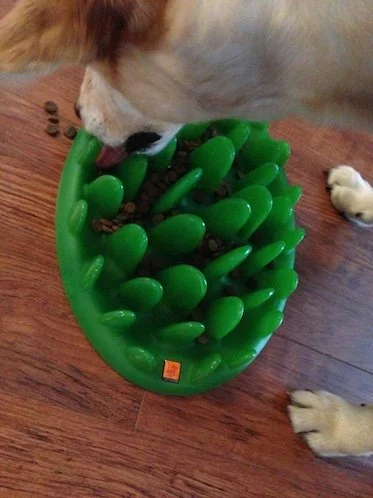Forget the food bowl: Interactive toys for dogs and how to use them
Whenever someone asks me how to change "nuisance" (nuisance to humans - normal to dogs) behaviors such as chewing, digging, barking, trash raiding, and counter surfing, one of my first recommendations is to replace the dog's food bowl with a variety of interactive toys.
Interactive toys are those that dogs play with by extracting something from the toy over a period of time. These toys are usually food-based, but not always. When dogs are taught to play with interactive toys as part of their mealtime routine, their meals become an opportunity for mental stimulation. The best part: this doesn't take much extra effort on the part of the human! When dogs dig, chew, and destroy, these behaviors are often a result of excess energy or a drive to do behaviors that are natural or normal to them.
When we don't give them appropriate outlets for these normal dog behaviors, they often make their own, and we usually don't like the ones they choose.When we use the dog's meals as a time for mental exercise and engagement, that breakfast that is normally takes 30 seconds for Fido to devour now takes around 15-20 minutes. Add in a dinner food toy, and now you've built 40 minutes of mental stimulation into your dog's day, with very little effort.
Add in a chew or a bone at another point in the day, or another food toy with treats or a special food like peanut butter or bananas, and add in a few 3-4 minute clicker training sessions, and you've got close to an hour of brain games for your dog every day. Combined with your walking, fetching, or tugging routines, you'll be off to a great start in defeating nuisance behaviors before they start.Some dogs don't play with interactive toys right away. You may need to help them enjoy the games by making them easier or helping them release the food temporarily, until they're able to do it enthusiastically on their own. Once they master the skill of getting the food out of the toy, you can find ways to make the toy more challenging. Some toys have built-in settings to adjust the difficulty.
For others, you may need to think creatively to make it more challenging. I suggest starting with the toy under or inside of something (like a milk crate or a cardboard shoebox), or freezing the food inside the toy, depending on the type of toy and the food inside. Keep in mind that most of these toys are not meant to be indestructible, so you should ways supervise your dog when she's playing with them.
So, what toys should you use? There are so many great interactive toys out there these days. Below is a list of my original favorites, but there have been many, many more added. Walk into a local pet store and ask about their puppy toys or do a search online, and you’ll find lots to choose from. If you have a favorite, leave it in the comments!

